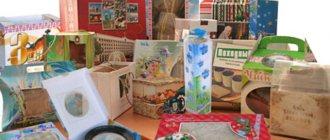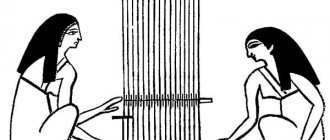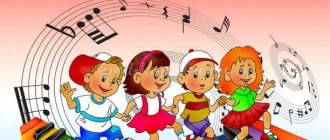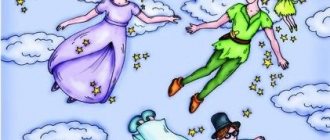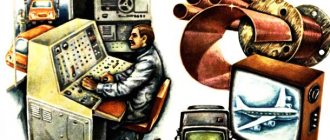Senior group. Senior preschool age. Children 5-6 years old
Summary of experimental activities in the senior group “The Magic World of Stone” Experimental activities in the senior group “The Magic World of Stone”
. Goal: Development of cognitive and research interest. Objectives: - develop the ability to examine objects of different shapes; - expand ideas about the texture of objects; - improve the dialogical form...
Lesson on experimenting with magnets in the senior group
Goal: To develop children's creative imagination in the process of finding ways to use magnets and inventing stories for games using them. Introduce how a magnet acts on its surroundings. Progress of the lesson: Educator: Guys, I am glad to welcome you to the country...
Summary of experimental activities in the senior group “Invisible Air”
Summary of experimental activities in the senior group
"INVISIBLE AIR"
Target:
develop children's cognitive interest in the process of experimenting with air.
Tasks:
Cognitive development:
- Develop cognitive activity and curiosity;
- Give an idea that air has properties: air is invisible, air is odorless; and also give an idea that wind is the movement of air;
- To promote mastery of various ways of detecting air (you can catch it, feel it);
- Learn how to conduct simple experiments with air;
- To form the foundations of an ecological culture, to cultivate a caring attitude towards the world around us, and a desire to explore it in all available ways.
Speech development:
Expand and activate children's vocabulary, develop coherent speech, enrich vocabulary: sailboat, atmosphere.
Social and communicative development:
Form partnerships among children in the process of research activities, the ability to work together.
Artistic and aesthetic development:
Develop attention, imagination, observation.
Form of study:
research and cognitive activities of children of the older group.
Amount of children:
subgroup.
Progress of educational and research activities:
-Guys, let's stand in a circle and greet each other.
We speak in unison.
-Hello, my friend,
Hello, my friend!
Hurry up and join me in a circle! Let's smile and say, "Hello!" To the sun: “Hello!”
And to all of us: “Hello”! We pass to each other in a circle: good morning Irina, etc.
- Guys, you asked me today: “What is this surprise in our group?” Want to know what it is? (Yes) Let's see. Guys, what is this? (Balloon, Dunno) What was he going to do? (Fly) Well, should we let Dunno fly? (Yes) Let's launch the ball.
- Guys, what happened? (The ball deflated) Will Dunno continue his flight? (Answers) Why? (Children's answer options, for example, the air has run out in the balloon) - Guys, do you know what air is? (No, yes) - But Dunno doesn’t know what air is and asks you to tell him about it. (Answers) - There is air around us and around the entire earth. It envelops the earth like a thick blanket. It's called atmosphere. What is his name Dima? Ask a few kids. Every living thing on earth breathes air. Plants and animals breathe air, and you and I cannot live without air. Place your hands on your stomach, inhale - draw in your stomach, exhale - inflate your stomach. Try holding your breath for a minute. How do you feel? Imagine what would happen if the Earth lost air? (answers) You see, guys, how important it is to have air.
-Why do you think air is called invisible? (It's invisible) Yes, it's transparent and we don't see it, but it's there. Do you know what other properties air has? (Answers) But Dunno doesn’t know. Who can help Dunno? (Answers) How can you help him? Remember, when you and I learned the properties of water, who did we turn into? (In scientists). - Let us turn into scientists again today and explore the air. And then we will be able to tell Dunno what this air is like. What do we need to do to become scientists? (Put on aprons) Where should we go to explore the air? (To the laboratory) What is a laboratory? (Answers) How should you work in the laboratory? Get to your seats.
Experience 1.
(standing)
Equipment:
Cellophane bags for each child.
- Guys, do you want to try to catch the air and see it? – You have bags and try to catch the air with them. Do you think it will work? Open the bag and make several wave-like movements. Then quickly close the bag. What do we see? (The package inflated)
-What do you have inside the package, there was nothing around us? (Air)
- What is this air like? (Transparent)
- Well done, that's right. You see, air is invisible, but we can catch it.
- Let's release the invisible man. Open the package. Set the bags aside.
What can we conclude? The air is clear.
-What needs to be done to see it? (You have to catch him to see him)
- We will indicate that the air is transparent and can be caught with this sign. (Show the sign and give it to the child who answers) Take care of it.
Experience 2.
Equipment:
glasses with a strip of paper glued, large glasses for each child.
- Guys, you can sit down now.
Take in your hands a small glass, inside of which there is a strip of paper glued to plasticine. Look carefully, what kind of strip of paper is it? (dry) Touch it. Turn the glass upside down and slowly lower it into a large glass of water. The glass must be held straight. What do you think will happen? (The paper will become wet) Continue immersing the glass in the water until it touches the bottom. Then remove the glass from the water and check the paper strip again. Is she wet or not? Why did the paper remain dry? (Answers)
- Guys, there is air in the glass, and it does not let water in. Air is everywhere, we don’t see it, but it is in all empty volumes.
What can we conclude?
Air is everywhere and it takes up space.
We will denote the fact that air occupies all empty volumes with this sign. (Show the sign and give it to the child) Take care of him.
Experience 3
.
Equipment:
One basin of water on the table (4 pieces), a sheet of paper, boats (4 pieces).
- Guys, how can you feel the air? (Inhale) What else? What if you try to wave? What will happen? How will you feel? (Wind, air) In very ancient times, people used a fan to keep them warm. Let each of you try to make your own fan. (Children fold leaves and make fans). If you fan, how do you feel? (breeze). How did this breeze come about? The fan moves and, as it were, pushes the air, makes the air move. The air also begins to move. Wind is the movement of air. Guys, what replaces a fan in our lives? (Fan)
What can we conclude?
Wind is the movement of air.
We denote that wind is the movement of air with this sign. (Show the sign and give it to the child) Take care of him.
- Guys, you have boats. Look, what's special about these boats? (Sail) Such ships are called sailboats. What are these ships called? Ask a few kids. Put these ships in the water and see what happens. (Nothing) What needs to be done to make the sailboat float? (Blow, wave) That's right. Give it a try. So, what helps a sailboat sail? (Wind) But the wind does not help all ships, but only which ones? (The wind helps sailboats)
- Guys, the wind can be a helper for a person, it is the wind that brings benefits. We will denote it with this picture. And sometimes the wind is a destroyer that causes harm. We will denote it with this picture. Now, we will try to figure out in which situations the wind helps and in which it causes harm. Let's get up and go to the table.
Didactic game “Which wind?”
Goal: to consolidate children’s knowledge about the phenomena of inanimate nature, the properties and types of wind.
Game rules: determine the positive or negative properties of the wind.
Game actions: Children look at the plot pictures and determine what kind of wind is depicted on them.
Didactic material: story pictures about the wind.
Progress of the game.
The teacher displays pictures of the wind on a magnetic board (good wind, evil wind). Children must determine where the wind is beneficial and where it is harmful.
— A sailing ship.
— The children are flying a kite.
— Strong wind in the forest and swaying trees.
— There is a strong wind outside, and the children are walking in the yard. (- Is it possible to walk outside during strong winds? It’s unsafe.)
Children glue the story pictures to the corresponding wind pictures on the board and explain why they did this.
“That’s how different the wind is, but now think about what the wind can be like?”
(Strong, weak, pleasant, affectionate, quiet, cool, warm, refreshing, gentle, pleasant, fast, sharp, unnoticeable)
- Well done boys. They explained to Dunno what the wind could be like.
What can be concluded?
Wind can be beneficial and wind can be harmful. (Give the signs to the children).
Experience 4.
Equipment:
chopped orange, lemon, garlic, perfume.
- Guys, while you were playing, Dunno asked me, does the air have its own smell? Take a deep breath. Did you smell it? Do you want to play the game “Recognize by smell” (Yes) But first, let’s remember how to inhale smells? How should the air be directed? (Careful, use your hand to direct the air flow) Then, come here, close your eyes and don’t peek. (Children are asked to guess the smell of orange, perfume, garlic with their eyes closed) - What smell did you smell? (Children's answers) Let's move on. (Go to 4 places)
— Does the air have its own smell? (No) - What can air do? What can air transmit? (Air can transmit odors.) - Well done, right. The air carries the smell of the substance that I suggested you smell.
What can we conclude
? Air does not have its own odor; air can transmit the odor of another substance.
We will denote the fact that the air does not have its own smell with this sign. (Show the sign and give it to the child). Take your seats.
Experience 5.
Equipment:
Candle on stand, glass lid, lighter. - Guys, what is this? (Candle) Let's light it and see what happens. I light a candle. The flame is burning.
— Can it pollute the air? (Answers) Hold the glass lid over the candle flame (at a distance of 1-2cm). After some time, we will see that this object has turned black from below - covered with a layer of soot.
- Guys, what's on the lid? (Dirt) You saw that even such a small flame can contaminate the lid. And if it contaminates the lid, what else does it contaminate? What is around us? (Air) That's right, burning flames pollute the air.
— Tell us, what else pollutes the air in our lives?
Children's answers: smoke from factories, fires, garbage dumps, cigarette smoke, cars.
— What helps purify the air? Plants and factories install special filters that purify the air; Plants are important air purifiers and air purifiers.
What can be concluded?
The air is polluted, but it can be purified.
We will indicate that the air is being polluted with this sign. And the fact that the air can be purified is so because the main air purifiers are plants. (Show signs and give to children who do not have signs).
Guys, what did we talk about today? (about air).
— Look at your signs-symbols, what properties of air do they represent? Irina, what is your ability? Please glue your property onto a sheet of paper in the designated place. Ask everyone. Children list the properties of air and go to glue their signs on sheets of paper.
- Guys, why did we study the air? Who did we help learn about air today? (Dunno) So that Dunno today does not forget what we learned about air, we will make a gift for him. The teacher bends the ends of the sheet and gets a pinwheel.
— Guys, there is one more interesting property of air, you can play with it. They even sell air toys. And you and I made such a toy ourselves. This is a fidget spinner toy. (Show: blow on the resulting pinwheel.) We will give it to Dunno so that he will not be upset that he could not fly.
- That's how much we learned about air today. Our study is over, please clear away your workspaces.

